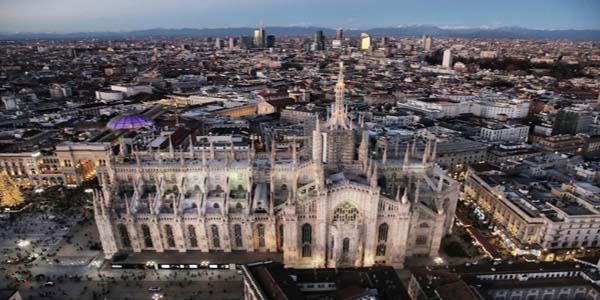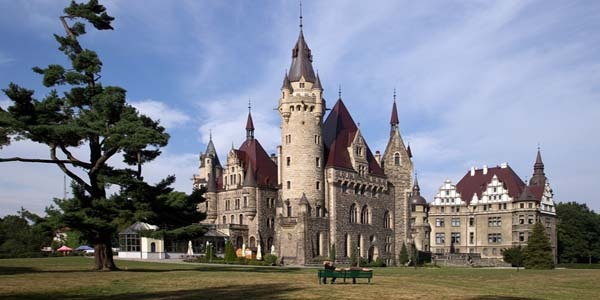Milano for living and Roma for the weekend. For years this was the stereotype that described the most important things to do in Milan and Rome. The first the work, the second the history; one the economic-financial primacy, the other the political-cultural one. Obviously things have always been more nuanced than that (Milan, for example, has always excelled in the field of publishing) and yet there is no doubt that this representation for years has basically held from an empirical point of view. After the success of Expo 2015 the picture has changed. Milan, in fact, has begun to run even touristically, to the point of undermining for number of annual visitors cities like Florence and Venice, settling immediately behind the capital of Italy.
On the other hand, it is precisely the sudden changes that best highlight some constants. In the case of Milan we can say that innovation and creativity have always been part of the city’s history. Not only, therefore, when things turn out for the best, but also when, as in the 90s of the last century, not everything has turned out right. In short, the Milanese spirit is what makes the city so fascinating, with evident reflections in various fields: fashion, design, gastronomy and the entertainment industry. Below we see the main attractions and things to do in Milan. Enjoy reading.
15 Best Things To Do And Visit In Milan, Italy:
- Duomo
- Museum of the twentieth century
- Vittorio Emanuele II Gallery
- Fashion quadrilateral
- Sforza Castle
- Branca Tower
- Brera Art Gallery
- Cenacolo Vinciano
- The Royal Palace of Milan
- La Scala of Milan
- Basilica of Sant’Ambrogio
- The Canals
- Monumental Cemetery
- Piazza Affari
- San Siro Stadium
Duomo
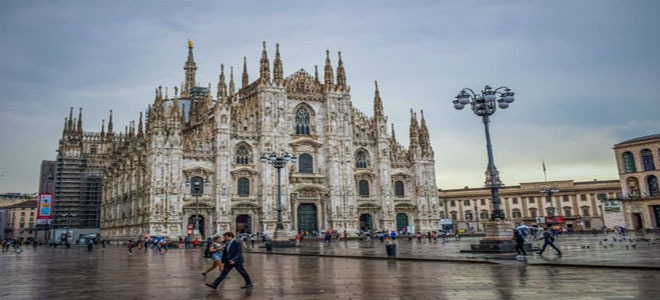
At the beginning we referred to creativity and innovation as constants in the history of Milan. To these two we must add a third one: the Duomo Santa Maria Nascente, in the center of the homonymous square. Since 1386, the year it was founded by Gian Galeazzo Visconti, this church represents the heart of Milanese spirituality, with over 4 million visitors a year. There is to say that to the popularity of the building concurs also the centrality of the square, junction for the almost totality of the things to do in Milan, and for this generally assumed like base of departure for the visit in the city.
From the architectural point of view the Cathedral represents a precious testimony of the gothic-lombard Gothic even if – it must be said – the construction of the cathedral has been protracted for over 5 centuries, so much that it is usual to distinguish 6 successive phases of realization: Viscontea (1387-1447); Sforzesca (1450-1520); Borromaica (1560-1650); Sei-Settecento (1650-1800); Ottocento (1800-1900); Novecento (1900-present). This very long time span also explains the high number of statues: over 3000 inside and outside, with the singular presence of lay personalities (Dante Alighieri, Arturo Toscanini, Vittorio Emanuele II and even the boxer Primo Carnera) alongside prophets and martyrs of the Old and New Testament.
The 135 spires that decorate the exterior of the Duomo, together with the Relic of the Holy Nail kept in a case at the top of the main apse (according to legend it is one of the nails of the cross of Jesus), are two of the most fascinating elements of the Duomo of Milan that – it is worth remembering – in Italy for size is second only to St. Peter’s in the Vatican. Not to be missed, moreover, the ascent on the roof (by elevator) and the visit of the underground with the archaeological remains of the original Basilica of Santa Tecla, on whose foundations Gian Galeazzo Visconti ordered the construction of the new temple.
Read also: Best places to visit in Liverpool
Museum of the twentieth century
If you like the art of the 20th century, in particular Futurism, which so much influenced from a cultural and political point of view the first half of the century, well then Palazzo dell’Argenario is a must to visit Milan. This building, a stone’s throw from the Duomo and Galleria Vittorio Emanuele II (see next point), since 2009 houses one of the most important collections of Italian art of the last century with great emphasis on the works of Boccioni, Marinetti, Balla and the other interpreters of that avant-garde movement that was Futurism. The exhibition, however, includes many other national and international artists, among others Picasso, Klee, Kandinskij, De Chirico, Modigliani, Fontana and Giuseppe Pellizza da Volpedo, author, the latter, of the famous “Fourth State” the painting that in fact sanctioned the irruption on the art scene, as well as of course on the political and social one, of the peasant masses and workers.
We have a guide with the best places to visit in Rome too.
Vittorio Emanuele II Gallery

There are those who have rightly defined the Milan tunnel as a station without rails, tracks and trains. In fact, the bustling streets are very similar to those of a railway station, with the substantial difference that here shopping is much more important than mobility needs. The Galleria Vittorio Emanuele II, in fact, is a real shopping mall with boutiques of the major haute couture brands alongside historic cafeer and fast food chains. Together with the so-called “Quadrilatero d’Oro” (see next point), the gallery, designed in 1865 by architect Giuseppe Mengoni, is one of the “stages” of the Milanese star system and showbiz. In short, there are those who come to watch and those who, instead, to be watched. Always beautiful, in the Christmas period, according to many people managed to visit Italy in 10 days, it is among the most beautiful things to do in Milan.
Discover when is the Best time to visit Cyprus
Fashion quadrilateral
In Milan it is impossible not to shop. We have already seen it with the Galleria Vittorio Emanuele II but it is the so-called “Quadrilatero della moda” (via Montenapoleone, via della Spiga, via Manzoni, via Sant’Andrea) the temple of Milanese shopping. Ferragamo, Prada, Valentino, Gucci, Krizia, Dolce & Gabbana, Trussardi, Chanel, Moschino, Versace and other great brands are practically all present in such a concentration that is not found anywhere else in the world, even in New York. Obviously there are few who can afford to buy in this area but this is not even the point. In fact, the most interesting aspect of the Quadrilatero della moda is that it is trend-setting, anticipating what will then be the tastes that will go for the most.
Things to do in Milan: Sforza Castle
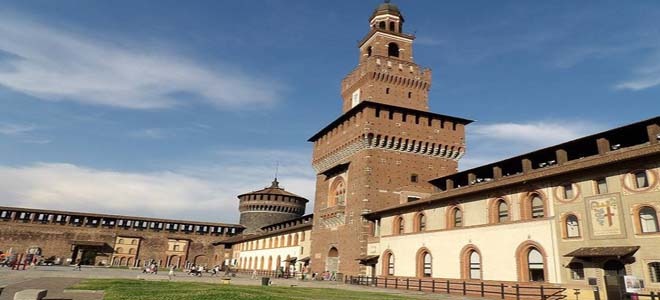
The Castello Sforzesco, another obligatory stop on a visit to Milan, is located not far from the Duomo. And, just like the city’s cathedral, the construction of this fortress is due to Gian Galeazzo Sforza who, continuing the initial work of his predecessor Galeazzo II Visconti, built the lodgings for the troops, at the same time rearranging the park and the moat all around. After the Visconti it was the turn of the Sforza family: first Francesco Sforza and then Ludovico Maria Sforza, called il Moro. The latter gave great prestige to the Milanese fortress, calling at court, among others, artists of the caliber of Leonardo da Vinci and Donato Bramante.
From the sixteenth to the eighteenth century the castle went through a very turbulent phase, passing into French, Spanish and Austrian hands. It is in these centuries that the image of a foreign fortress, a hostile symbol of occupation, settled. A negative prejudice that the Milanese have left definitively to the shoulders only after the Unity of Italy. Coming to the present day there are two reasons why the Castello Sforzesco is one of the main tourist attractions and things to do in Milan. The first is because, just behind it, there is the beautiful Parco Sempione, an oasis of peace in the city center. Being able to pull the plug without having to stray too far from work and current affairs is certainly a great advantage, all the more so in a busy and always rushing city like Milan.
The second reason is the presence, inside the building, of several museums. First of all the Museum of Ancient Art, with the section dedicated to the Rondanini Pietà by Michelangelo, but also the Museum of Musical Instruments, the Prehistoric Museum and the Egyptian Museum are worth a visit. In short, whether you are looking for a bit of relaxation or, on the contrary, cultural stimuli that leave a mark, the Castello Sforzesco is one of the must-see places in Milan. For more information visit the official website: milanocastello.it.
Read also: Places To Visit In Vienna In 2 Day
Branca Tower
The Sempione Park mentioned above (see Castello Sforzesco, point 5) is not only the green lung of Milan but also – above all – a place of memory that bears many traces of the recent history of the city. From the monument commemorating Napoleon III, to the Arena of Antonio Canova, where Inter and Milan played as well, passing through I Bagni Misteriosi, the fountain designed by Giorgio De Chirico, the favorite park of the Milanese exudes history, culture and art.
Special mention for the Branca Tower, which is located right at the entrance of the park. It is a metal tower designed by designer Gio Ponti and built in 1933 on the occasion of the 5th Milan Triennale. It is called Torre Branca because in 1972, the Branca brothers, owners of the Branca distillery of the same name, took charge of the renovation of the work, which had been uninhabitable for some time. In addition to the combination, still current, between architecture and technique, the peculiarity of this metal totem is that an elevator allows you to climb to the top (108 mt), from which you can enjoy a beautiful view of the city. Not to be missed!
Read also: Best beaches in Spain
Brera Art Gallery

The first thing that catches the eye of the Brera Palace is the statue of Napoleon Bonaparte in the courtyard before the entrance. Created by the artist Antonio Canova, the sculpture depicts the leader in the guise of the Roman god Mars, celebrating not only his qualities of conquest but also his role as a civilizing hero. What we think for one of the best things to do in Milan, however, is a bronze copy of the work, since the marble original is in the Wellington Museum in London. And Napoleon, after all, also has something to do with the Brera Palace’s main attraction, the famous Art Gallery with hundreds of paintings from the Middle Ages to modernity. Napoleon, in fact, used this former Jesuit college as a repository, and there were many works of art confiscated around northern Italy.
A form of state collecting that marked a profound change from private collecting from which, for example, the Uffizi Gallery in Florence sprang. In any case, a fortune for Milan that some of the greatest masterpieces of Renaissance art were found “at home”. Just to remember some of them, without claiming to be exhaustive: the Pietà by Giovanni Bellini, the Dead Christ by Andrea Mantegna, the Marriage of the Virgin by Raphael and the Dinner in Emmaus by Caravaggio. In short, the Pinacoteca di Brera is another obligatory stop of a visit to Milan, especially since the collection, as mentioned, does not end only in the fifteenth and sixteenth centuries but also houses significant contributions of Flemish art, not to mention some of the best interpreters of Italian painting at the turn of the nineteenth and twentieth centuries.
Read also what to do in Sintra
Things to do in Milan: Cenacolo Vinciano
For notoriety the Last Supper of Leonardo is second only to the Mona Lisa kept in the Louvre in Paris. Probably to the (relative) lesser fame of Leonardo’s Last Supper contributed the rapid deterioration of the work that the Florentine artist painted on the wall of the refectory of the Dominican Monastery of Santa Maria delle Grazie. To commission the painting, 4 meters high and 9 meters long, Ludovico Il Moro who strongly pushed for the representation of the announcement of the betrayal that Jesus addressed to the apostles before being arrested.
A scene to which Leonardo managed to transfer all the drama of the biblical story, painting on the faces of the apostles the disbelief for listening and the contemporary fear of being pointed out by the prophet. From 1977 to 1999 Leonardo da Vinci’s Last Supper was the object of one of the longest and most complicated restoration campaigns ever experienced. An enormous work that has allowed the satisfactory recovery, even if only partial, of one of the absolute masterpieces of the Renaissance on which the Florentine genius worked for three years, from 1494 to 1497. To see the Cenacolo Vinciano it is necessary to make a reservation, which can be done either by phone (calling 02 92 800 360), or online from the following site: www.vivaticket.it (from which you can also book a visit to the Pinacoteca di Brera, see previous point). Not to be missed!
We have also: Most beautiful Greek Islands
The Royal Palace of Milan
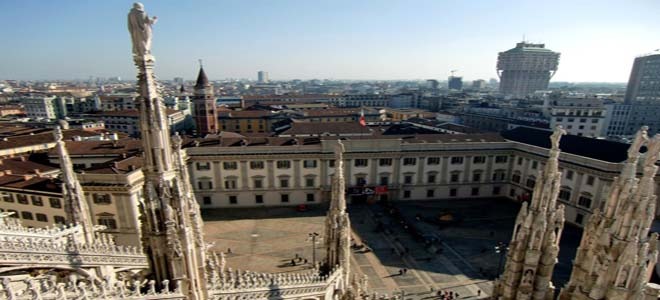
Seat of the Milanese government for many years, the Royal Palace of Milan has become an important cultural center of the city. Every year a series of exhibitions are organized, both modern and contemporary art, fashion or design. The Royal Palace is over 7,000 square meters large and houses many paintings on loan from some of the most prestigious museums in the world. You can also visit the palace museum. It presents both its own history and that of the city and population of Milan. Divided into 4 parts, the museum allows you to explore the Neoclassical, Napoleonic and Risorgimento periods, ending with the unification of Italy, a very important period in the history of Milan.
Discover also: What to do in Slovenia
La Scala of Milan
From Piazza del Duomo, along the Galleria Vittorio Emanuele, you will arrive directly in Piazza della Scala. As the name suggests, it is the place where La Scala, the famous Milan Opera House, is located. Together with the Teatro San Carlo in Naples and the Fenice in Venice, it is one of the 3 most prestigious opera houses in Italy. Here have been created masterpieces of Italian opera, such as the “Norma” by Vincenzo Bellini or the “Otello” by Verdi.
In addition, one of the greatest opera singers of all time has also performed at the Teatro La Scala: Maria Callas. We have not had the opportunity to see the inside of it, but it is famous all over the world for being truly sumptuous. So we suggest you to visit it if you have the opportunity! The exterior, however, is quite simple. On the left side of the building you can visit the Museo della Scala and its collection of musical instruments, opera costumes and historical documents. If you wish to see a concert, opera or ballet at La Scala, you can buy tickets directly from the official website.
Basilica of Sant’Ambrogio
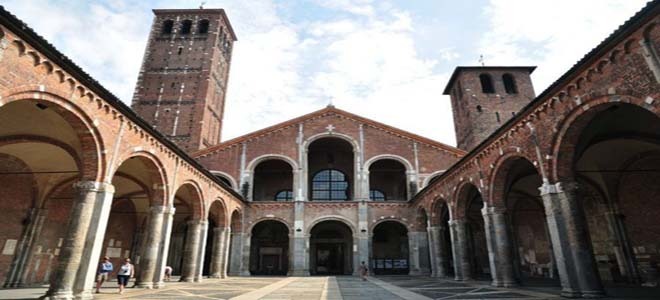
Second in importance only to the Duomo, the Basilica of Sant’Ambrogio should be on your things to do in Milan list undoubtedl. Its importance goes beyond the religious aspect and directly affects another cornerstone of the city’s identity: the close link between the local church and civil society. This relationship is one of the secrets of Milan’s success, since it has historically allowed the most dynamic part of the city to experiment and innovate chasing profit, leaving the church to take care of the latter. That said, the basilica of the patron saint also deserves from an architectural point of view.
Art historians, in fact, agree in considering it the most shining testimony of the Romanesque-Lombard, a source of inspiration for the construction of many other churches around the region. To see, the Sacello di San Vittore in Ciel d’Oro, a small chapel near the altar famous for the mosaics that decorate the walls and the barrel vault. Same importance for the Golden Altar made by master Vuolvinio, a very active goldsmith in the 9th century. From the same period the oldest of the two bell towers, made by Benedictine monks. The other, the taller one, was built three centuries later by the canons in a long conflict between the parties about the use of the church altar.
Read also: Best things to do in Dublin
Things to do in Milan: The Canals
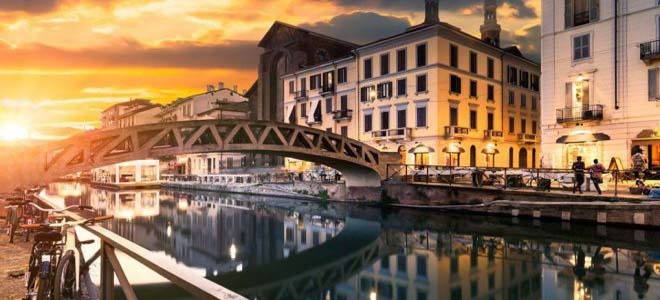
The Navigli, about half an hour’s walk from the Duomo, are one of the most interesting areas of Milan. They are so both for their historical importance in the past and for the tourist present that began in the 80s of the last century and finally exploded after Expo 2015. Walking along the Naviglio Grande and the Naviglio Pavese, the two waterways around which the district extends, it may seem like being in Amsterdam or Stockholm, which is incredible considering that unlike the two northern European cities, Milan has never had large waterways.
On the contrary, the Navigli were born precisely to make up for the absence of a main waterway by drawing on the small Seveso, Lambro and Nirone to provide the city with a river port that would facilitate trade. To fully understand the historical value of this great work of hydraulic engineering, to whose realization also Leonardo da Vinci contributed, just think that the marble blocks used for the construction of the Duomo were transported entirely along the navigli. In the nineteenth and twentieth century the prevalence of transport by road and iron decreed a slow but inexorable decline of the neighborhood, in the meantime inhabited mainly by workers who were absorbed by the industries around the city.
At the end of the 20th century, instead, the decline of industry, to the advantage of the tertiary and finance, accompanied a further transformation of the area, frequented by artists and the new town bourgeoisie. With the new millennium, the definitive tourist consecration with the opening of bars, restaurants, trattorias and an infinity of other commercial activities that have made the Navigli one of the highlights of Milan’s nightlife. There is not only this however. Next to the canals, including the Martesana Canal, which has not been mentioned until now, the network of cycle paths has been strengthened, so as to allow those who want it, the knowledge of the other Milan, that of areas such as Crescenzago, Gorgonzola, Assago, Rozzago etc.. otherwise neglected by traditional tourist tours for most famous things to do in Milan. Not to be missed!
Monumental Cemetery
Among the symbols of Milan, next to the Duomo and the Basilica of Sant’Ambrogio, there is also the Monumental Cemetery. Not only because there are buried personalities who have made the civil, political, artistic and literary history of Italy (just to remember some of them: Alessandro Manzoni, Filippo Turati, Salvatore Quasimodo, Arturo Toscanini, Giorgio Gaber and Franca Rame) but also because this huge space of over 250,000 square meters, offers many architectural cues. More in detail, the peculiarity of the Monumental Cemetery of Milan consists in incorporating different styles from Gothic to Art Nouveau, passing through Romanesque, Byzantine and Neoclassical. In short, at the same time a place of memory and an example of architectural eclecticism that deserves to be visited and enhanced.
Piazza Affari
If you have some time during your trip to Milan, go to the square where the business takes place in Milan to admire a rather unique monument. Located in front of the Milan Stock Exchange in Piazza Affari, you will find a magnificent marble statue of 11 meters representing a giant middle finger. Named L.O.V.E. (Libertà, Odio, Vendetta, Eternità), the statue was created by the Italian sculptor Maurizio Cattelan as a sign of mockery towards the financial institution. It was harshly criticized and should have been removed only a few months later, but for now, it is still present since 2010.
San Siro Stadium
San Siro is not a stadium like the others. The historical definition of “soccer ladder” is enough (in evident similarity with the Teatro alla Scala, always in Milan) to understand the emotional bond of the Milanese with this stadium where the two glorious city teams, Inter and Milan, alternate. Since a few years, in addition to the museum, it is possible to visit all the interiors retracing the real itinerary of the players: mixed area, dressing rooms, tunnels, playing field and even the stands. In short, once in Milan, especially if you care about one of the two teams, a visit to the Giuseppe Meazza of San Siro is a must. The Museum & Tour is open every day from 9:30 to 18:00.

